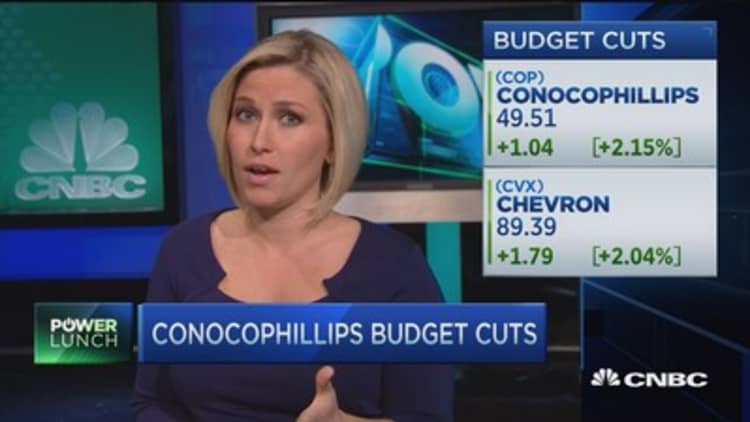Oil giants Chevron and ConocoPhillips said this week they'll slash spending in 2016. But those cuts won't translate to less oil coming out of the ground.
Crude output from non-OPEC countries is forecast to tick down next year, with the biggest declines coming from the United States, according to federal data. But those reductions are seen coming from the independent producers of high-cost shale, not from the big, multinational oil giants.
Total U.S. output will fall to 8.6 million barrels per day next September from last April's peak of 9.6 million , according to the Energy Information Administration's latest short-term energy outlook. The agency also sees moderate declines in Norway, Britain and Russia.
ConocoPhillips said Thursday it will spend $7.7 billion on capital expenditures in 2016, down 25 percent from 2015 and a whopping 55 percent from 2014. Still, the company sees production increasing by 1 to 3 percent next year.

Even then, ConocoPhillips said it has significant flexibility to cut spending further should market conditions take a turn for the worse. The company would need to spend roughly $6 billion to maintain current production, Matt Fox, executive vice president of exploration and production, said on a conference call Thursday.
The major producers also have many levers to pull because of their size and scope. ConocoPhillips has bolstered its balance sheet by cutting $1 billion in expenses — primarily from well operations in the United States — improving operating costs by 15 percent in the last year.
ConocoPhillips' ouput can still rise because the company has long-running projects for which 2016 is the first key year of production, Evercore ISI analyst Doug Terreson told CNBC in an email. Those projects include production increases at an Australian liquid natural gas facility and in Canadian oil sands operations.
Chevron, Hess and Occidental Petroleum also have new projects in the pipeline that can support production growth, he said.
Chevron announced plans Wednesday to cut capital spending by 24 percent next year, to $26.6 billion. The company will not issue production forecasts until it reports earnings in January, but management previously said it expects production growth of 13 to 15 percent — about 2.9 million to 3 million barrels per day — by the end of 2017.
Meanwhile, for the shale producers...
Meanwhile, analysts told CNBC they expect average annual production by U.S. shale producers to decline by 400,000 barrels per day in 2016. These drillers have to pump large volumes of water, minerals and chemicals deep below the surface to free oil and gas from shale deposits, a process called hydraulic fracturing.
Energy investment bank Tudor, Pickering, Holt & Co. is expecting only moderate aggregate production declines — perhaps a few percentage points — for the roughly 40 publicly traded shale producers it follows, said Mike Rowe, vice president of exploration and production research.
Because their value proposition is all about growth, business models will be called into further question on those announcements, and I suspect consolidation will follow. The silence from those companies is deafening so far.Doug TerresonEvercore ISI analyst, on the shale oil producers
The bigger declines are likely to come from private exploration and production companies, which generate roughly 30 to 35 percent of U.S. oil supply, he said. Those firms don't have the same access to capital and are more focused on returns than growth rates, compared with public companies.
Indeed, stripper wells, which produce 15 barrels per day or less and are typically operated by small outfits, could be particularly vulnerable, Edward Morse, global head of commodities research at Citigroup, told CNBC last month.
But even among publicly traded companies, the ability to fund new development will be influenced by geography and the type of ground they drill in.
Producers with holdings in West Texas' Permian Basin are well positioned, in part because they can tap capital markets based on the quality of their assets, Rowe said. By comparison, many producers in North Dakota's Bakken shale, for instance, will be forced to fund new production with operating cash flow.
"Investors view the size of the prize to be much greater in the Permian, so investors are much more willing to look through this low point in this cycle," he said.
But investors should expect shale production to fall more sharply after 2016 if prices remain low, Rowe said. Currently, 12-month average futures prices don't show crude rising above $50 until the back half of 2017.
Terreson said he suspects shale producers to announce production declines for 2016.
"Because their value proposition is all about growth, business models will be called into further question on those announcements, and I suspect consolidation will follow," he said. "The silence from those companies is deafening so far."




